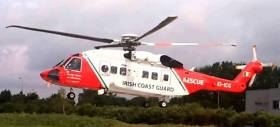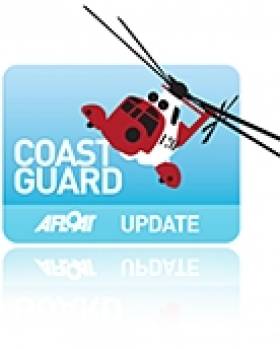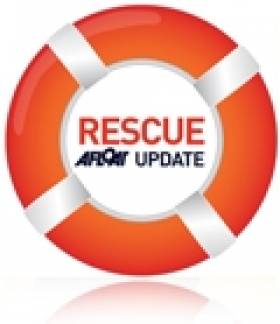Displaying items by tag: Search & Rescue
Search Resumes For Swimmer Missing Off Bundoran
#Missing - The search resumed at first light this morning (Wednesday 24 August) for a swimmer reported missing off Bundoran in Co Donegal yesterday evening.
BreakingNews.ie reports that the man got into difficulty while swimming at Tullan Strand.
The alarm was raised by a beachgoer in the adjacent car park after a group of swimmers called for help, according to RTÉ News.
Bundoran RNLI and the Irish Coast Guard's Sligo-based helicopter Rescue 118 are involved in the search that was suspended overnight.
Galway Coast Gets New Volunteer Search Unit
#Galway - Galway Bay FM reports on a new volunteer search and rescue unit set up near the city weeks after community efforts to locate missing NUI Galway student Michael Bulger.
As previously reported on Afloat.ie, Bulger's body was recovered from the water near Oranmore on Galway Bay early last month after three weeks of searches largely driven by local volunteers.
Now the Oranmore-Maree Costal Search Unit, which will hold a public meeting on Monday week, hopes to harness those efforts across a 30km span of coastline split into nine zones with the co-operation of the Garda, Civil Defence and the RNLI.
Galway Bay FM has more on the story HERE.
#CaernarfonSAR – The launch of the Caernarfon civilian UK search and rescue (SAR) helicopter service was marked today (Wednesday 8 July) in a ceremony held at the new SAR base at Caernarfon Airport in North Wales.
Bristow Helicopters Ltd, is operating the search and rescue Helicopter service for the UK on behalf of HM Coastguard. The UK limited company was awarded the ten year UK SAR contract by the Department for Transport in March 2013. By 2017, it will deliver the service from ten bases strategically located close to areas of high SAR incident rates.
The Caernarfon base went live on 1 July 2015 and has already responded to taskings from the Aeronautical Rescue Coordination Centre (ARCC).
Bristow crews are delivering the UK SAR helicopter service on behalf of HM Coastguard with state-of-the-art helicopters, equipped with the latest search and rescue technology including night vision, mission management and increased onboard medical capabilities.
The base was officially opened by Richard Parkes, Director of Maritime Operations at the Maritime and Coastguard Agency (MCA), and was attended by representatives from the Royal Air Force 22 Squadron. Also in attendance were other search and rescue organisations and invited guests with whom Bristow and HM Coastguard have been working closely, and who have been instrumental in preparing the new service.
Speaking at the launch event Mr Parkes said: "HM Coastguard has been providing search and rescue helicopter services in northern Scotland and southern England for over thirty years. Today I am immensely proud to be welcoming our first civilian base to Wales.
"I would also like to pay tribute to the outstanding work that RAF Valley has carried out over many decades, both inland and out to sea. We will ensure that their legacy is continued."
Samantha Willenbacher, Director of UK Search and Rescue at Bristow Helicopters Ltd, said: "Bristow Helicopters Ltd has a long history in providing search and rescue services on behalf of HM Coastguard and the commencement of services from our first Welsh base is a significant milestone. It is important that we acknowledge the incredible service and numerous lives saved by the crews of 22 Squadron at RAF Valley and we are honoured to be continuing this vital emergency service from our new base in Caernarfon.
"I would like to thank all of those here in Caernarfon and around the UK who have supported us in our preparations for the service going live. We look forward to becoming a part of your community."
The company's aircraft and crews have been at the Caernarfon base since May 2015 making preparations for the service going live and conducting a raft of training exercises with local search and rescue partners.
The base is led by Anglesey-local Chief Pilot Captain David Kenyon, a former SAR Unit Commander, Senior Pilot and Instructor at nearby RAF Valley. Capt Kenyon joined the RAF in 1992 and flew SAR tours from bases at Leconfield, Lossiemouth and Boulmer before moving to Valley. In 2006 he received the Air Force Cross, one of the country's highest gallantry awards, following the rescue of a climber who had suffered serious injuries in a fall close to the summit of Glyder Fach in Snowdonia in atrocious weather conditions. Since leaving the RAF in 2009 Capt Kenyon has worked in a number of countries including most recently Ireland as Chief Pilot and operational SAR captain with the Irish Coastguard in Sligo.
Captain Kenyon said: "This area is very much home for me and I am looking forward to providing this essential service to my local community. The role is very similar to the one I had during my military time and I know the area of operations very well.
"We are extremely grateful to the local community and to those at Caernarfon Airport for making us feel so welcome. It has been a pleasure in recent weeks to work closely with many of the other search and rescue organisations in the region in preparation for the service going live; their experience and professionalism is a real asset to the community."
Roy Steptoe, Director of Caernarfon Airport, said: "We welcome the opening of Bristow's new search and rescue base at Caernarfon Airport and the investment that has been made in the new facilities. This is a vital service for the community and we are proud to be able to support the operation."
ComReg launches Personal Locator Beacon (PLB) Registration Website
Personal Locator Beacons, or PLBs, are portable radio transmitters, which aid the Search & Rescue (SAR) emergency services in the detection and location of persons in distress. These devices operate in a similar manner to Emergency Position Indicating Radio Beacon (EPIRBs) onboard vessels and Emergency Locator Transmitters (ELTs) onboard aircraft, but are unique in that they for personal use and are not registered to a particular vessel or aircraft.
ELTs and EPIRBs have been in operation for several years are proven technologies, which have resulted in many successful search and rescues missions since their inception. More recently technological advances have enabled the construction of light-weight, hand-portable distress transmitters and hence the relatively recent emergence of PLBs onto the market.
In order to maximise the effectiveness of PLB usage, each PLB should be registered so that owner details as well as location details can be communicated to the emergency services which in many cases assists in speeding up rescue operations.
PLB owners can now register their PLB in Ireland using ComReg's new web portal. For more information on how to register your PLB please go to www. Comreg.ie or contact [email protected] or phone 01 804 9600.































































